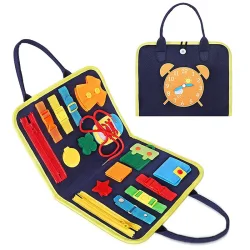Types of activity toys
2024-02-26
Activity toys refer to a wide range of play items designed to engage children physically, mentally, and sometimes socially. These toys are created to stimulate various aspects of a child's development, including motor skills, cognitive abilities, creativity, and social interactions. Here are some types of activity toys that cater to different developmental needs:
1. Building Blocks:
- Blocks of various shapes and sizes encourage creativity, spatial awareness, and fine motor skills. Children can use them to build structures and learn basic principles of balance and stability.
2. Puzzles:
- Jigsaw puzzles come in different levels of complexity, promoting problem-solving skills, hand-eye coordination, and cognitive development.
3. Art Supplies:
- Crayons, markers, colored pencils, and other art supplies allow children to express their creativity, improve fine motor skills, and explore colors and shapes.
4. Play Dough:
- Play dough offers a hands-on sensory experience, allowing children to mold and shape different figures while enhancing their tactile and fine motor skills.
5. Educational Games:
- Board games and card games designed for specific age groups help children learn and reinforce concepts such as numbers, letters, colors, and social skills.
6. Musical Instruments:
- Instruments like drums, tambourines, shakers, or xylophones encourage rhythmic exploration and auditory development.
7. Ride-On Toys:
- Tricycles, balance bikes, and ride-on toys contribute to the development of gross motor skills and coordination while providing a sense of independence.
8. Sports Equipment:
- Mini soccer balls, basketball hoops, or soft baseball sets introduce children to basic sports skills and promote physical activity.
9. Dress-Up Clothes:
- Costumes and dress-up clothes encourage imaginative play, allowing children to role-play and express their creativity.
10. Dollhouses:
- Dollhouses with miniature furniture and figures promote imaginative play, storytelling, and social interaction.
11. Educational Toys:
- STEM (Science, Technology, Engineering, and Math) toys, robotic kits, and science experiment sets foster curiosity and learning in areas like physics, engineering, and mathematics.
12. Outdoor Play Equipment:
- Swings, slides, climbing structures, and playhouses encourage outdoor play, social interaction, and physical exercise.
13. Interactive Learning Toys:
- Toys with interactive features, such as electronic learning tablets, can provide educational content while keeping children engaged.
14. Role-Playing Sets:
- Sets that mimic real-world scenarios, like kitchens, doctor's kits, or toolsets, encourage imaginative role-playing and social development.
15. Language Development Toys:
- Books, flashcards, and storytelling toys promote language development, vocabulary building, and early literacy skills.
When choosing activity toys, it's important to consider the child's age, interests, and developmental stage. A mix of different types of toys can provide a well-rounded and stimulating play environment, supporting a child's growth and learning. Always prioritize safety by selecting toys appropriate for the child's age and regularly checking for any potential hazards.



